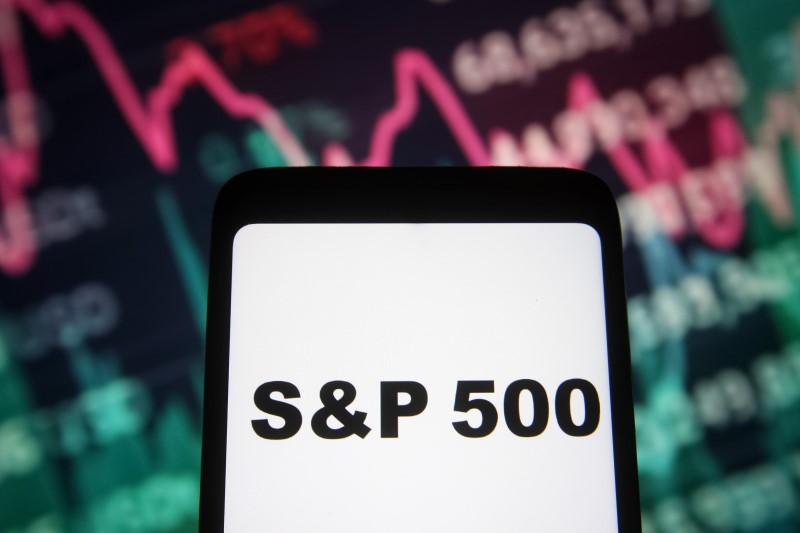By Mike Dolan
LONDON (Reuters) – As so often with markets, it may be time to get a bit anxious when all around see nothing but blue skies.
Trot out almost any macro market metric you care to think of these days and there appears to be a positive twist – at least for record high stock markets that have clocked up more than 10% gains for a first quarter that was marked at the outset by much investor angst and trepidation.
U.S. stocks are expensive but not at extremes, it’s argued, and earnings forecasts for next year are rising smartly to near 14%. U.S. economic growth is slowing a bit but recession this year now seems far fetched.
Still-high interest rates are set to start falling over the summer as somewhat sticky inflation subsides again. And implied volatility gauges in stock, bond and currency markets are unusually subdued.
The picture outside the United States may be patchier, but stocks in Europe or Japan are cheaper too and the economic growth nadir in both areas may already have passed. European rates may even start falling before U.S. equivalents.
What’s more, the big bugbear of the past 18 months for many – stock index gains that had been overly concentrated in a handful of Big Tech and AI-infused winners – is starting to resolve and gains are clearly broadened out as recession fears fade and rate cuts near.
From the trough of last October’s bond-related shakeout, the benchmark S&P500 has gained 25% in just 5 months.
But the equal-weighted version of the index – which corrects for the outsized performance of leading megacaps – has jumped 23% in that time, small caps have rebounded 26% and Japanese and euro zone blue chips are up 28% and 25% respectively in dollar terms.
Reflected in those stellar gains, the hand-wringing of the early part of the new year seems to have stopped completely.
The most recent Bank of America global fund manager survey has stock allocations at two-year highs and the highest ‘risk appetite’ gauges since November 2021. Prior to November there had been a net underweight position in equity for 18 months straight – the longest gloomy streak since crash of 2008/09.
Have all the doubters turned to believers?
And have the bears finally capitulated after 18 months of bruising underperformance?
If they have, it unnerves some asset managers who have been happy to swim against the early-year pessimism – even those who mostly agree with the bullish thesis.
Swiss asset manager Julius Baer’s chief investment officer Yves Bonzon said he is starting to wobble on his still-overweight equities position – fearing a combination of herding consensus, a seasonal lull in equity demand over the summer and the upcoming U.S. election uncertainty.
“We’ve been tempted for the best part of four weeks to reduce at the margin equity risk and hedge,” he said. “We refrained from doing do so so far, but if you were to force me to add or reduce equities I’d be tempted to slightly reduce.”
“There’s going to be a consolidation phase between now and November in the markets – a 10-15% correction could happen at any time and would, I’d argue, be healthy,” he added.
“Shocks are by definition impossible to foresee (but) markets are probably more vulnerable than we have been to an external shock than at any point since COVID hit in 2020.”
BACK TO THE FUTURE
Curiously, a 10% correction of the S&P500 from current levels would only leave it roughly back at where end-2024 consensus forecasts were as recently as November, according to Reuters global equity polls.
That end-2024 median forecast has been revised up sharply in last month’s polls to 5,100 and to 5,300 for the end of 2025.
But we’re already there for the most part.
What to do – keep riding the wave or hedge bets a bit?
With implied 30-day equity volatility captured by Wall St’s just 3 points from record lows, there may be some temptation to hedge equity portfolios with options.
But many asset managers have used punchy short-term cash interest rates of more than 5% as effective hedge instead.
And many are now both overweight equities and cash simultaneously.
According to data from the Investment Company Institute, U.S. money market fund assets topped $6 trillion this month for the first time ever – almost a $1 trillion more than they were a year ago and almost twice pre-pandemic levels.
And that’s one key reasons why investors are reluctant to turn tail on equities short of some dramatic about turn on the benign macro economic picture.
The assumption is that cash stash is there until the Fed finally starts to cut short-term interest rates – and futures have that penciled in for June. Then it starts to stream out to either bonds or equity.
If the Fed were to hesitate in easing in the second quarter, then it could be a bumpy summer.
U.S. election uncertainty then hoves into view to complicate any bounceback – even if you believe the bullish economic backdrop holds true through 2025 regardless of the result.
AXA Investment Managers’ Chris Iggo points out the average return of the in U.S. Presidential election years has been around 11%. And that’s what it’s done already in 2024.
But “if we are now in a benign growth cycle – then financial market returns could be more like their long-term averages,” he wrote. “That means slightly higher for bonds than in recent years and slightly less for equities than over the last year. But good overall.”
Bullish and bearish at the same time perhaps.
The opinions expressed here are those of the author, a columnist for Reuters.


